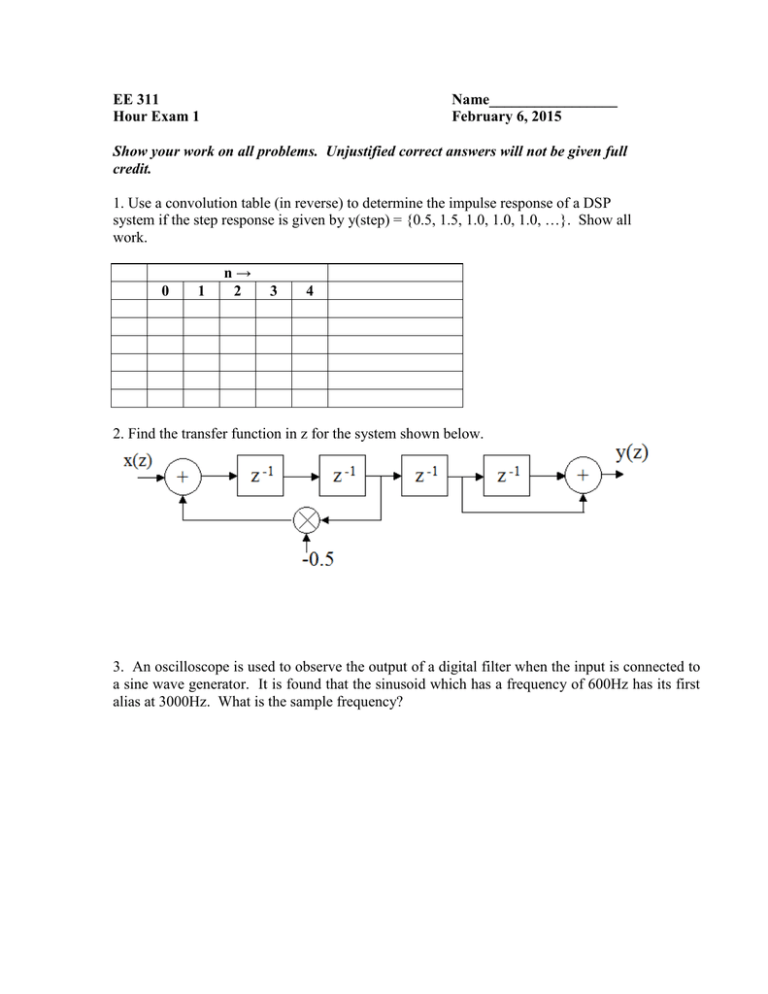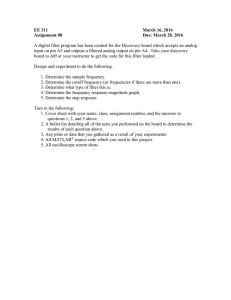EE 311 Name_________________ Hour Exam 1 February 6, 2015
advertisement

EE 311
Hour Exam 1
Name_________________
February 6, 2015
Show your work on all problems. Unjustified correct answers will not be given full
credit.
1. Use a convolution table (in reverse) to determine the impulse response of a DSP
system if the step response is given by y(step) = {0.5, 1.5, 1.0, 1.0, 1.0, …}. Show all
work.
0
1
n→
2
3
4
2. Find the transfer function in z for the system shown below.
3. An oscilloscope is used to observe the output of a digital filter when the input is connected to
a sine wave generator. It is found that the sinusoid which has a frequency of 600Hz has its first
alias at 3000Hz. What is the sample frequency?
4. Answer the questions below for the system given by: H ( z ) =
− z −1
z − .6 z + 0.5
2
A) What is the gain of the filter at 0Hz?
B) What is the phase of the filter at 0Hz?
C ) What is the gain of the filter at fs/2?
5. Consider the following difference equation:
y(n) = x(n) + 0.5x(n-1) + 0.25y(n-1) – 0.5y(n-2).
A) Find the transfer function in z.
B) Is your transfer function stable?
6. An ideal square wave is passed through an ideal band-stop filter. The square wave has
a frequency of 1 KHz and an amplitude of ± 1 volt. The ideal band stop filter stops all
frequencies between 900 Hz and 1200 Hz. What frequencies, if any, will be come
through the filter?
7. Given the transfer function below for a DSP system in which k1 and k2 are a real
constants.
z + k1
H ( z) = 2
z − 1.6 z + k2
A) Assuming that k2 is chosen to make the roots complex, determine the range of values
for k1 and k2 that make the system stable.
B) If k2 = 1 what is the range of values of k1 to give H(z) a 180o phase shift at 0 Hz.
8. Draw a sketch of the frequency spectrum of the following signal:
u (t ) = 3 sin(377t ) + 1.5 cos(754t − 3π / 2) − 5 sin(1131t + 2π / 3) .
Be sure to label the frequency and gain axis with the appropriate scale numbers.
9.Two systems have the same impulse response. If the systems are know to be linear, are
the two systems identical? Explain why or why not. In your answer address the
following questions:
A) Are the components the same?
B) Are the transfer functions the same?
C) Are the step responses the same?
10. Answer the following questions about the filter in the figure below.
a) Is this an FIR or IIR filter? How do you know?
b) What are the first 3 terms of the impulse response sequence for this filter?
c) Write a transfer function in z for the filter.
d) What is the gain of the filter at 0Hz? _________
e) What is the phase shift for the filter at 0Hz?_______




